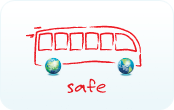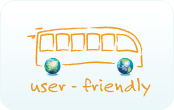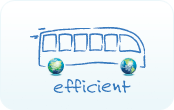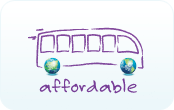|
// Connected mobility 2025
|
|
Personal mobility is key to the success and prosperity of a country's economy. But population growth, and therefore the increase in traffic in the world's largest megacities lead to paralysis.
This study on the socio-economic costs of traffic congestion in 30 of the world’s major cities highlights that the integration of various transport modes would have a positive impact in environmental terms, but also on the quality of life and would save USD 266 billion per year to the world’s 30 largest megacities.
With more than 1 billion smartphones in the world, the conditions to provide access to information in real time, anywhere, are already in place.
|
|
// Information about the coach terminal itself and services offered on-site
|
|
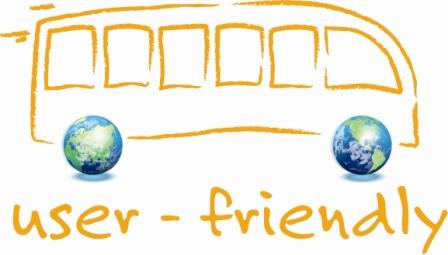 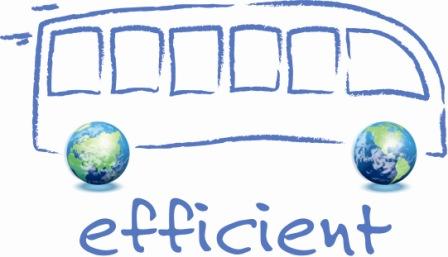 Information about the coach terminal itself and services offered on-site have to be made available for current and potential users. Services that nobody knows exist or that nobody knows how to use are worthless. That is why, information platforms of various types are necessary in order to increase the awareness of the existence of transport and other services amongst potential and already existing coach terminal users. Information about the coach terminal itself and services offered on-site have to be made available for current and potential users. Services that nobody knows exist or that nobody knows how to use are worthless. That is why, information platforms of various types are necessary in order to increase the awareness of the existence of transport and other services amongst potential and already existing coach terminal users.
Through the publication of coach terminal plans, websites, information counters and stands, people would be informed about the possibilities for reserving travel tickets, general information on availability of services, coach routes, destinations, potential alternative solutions, schedules, duration of travel, travel costs and possible reductions.
Furthermore, information on various options of payment and cost compensation in case of travel cancellation should be provided. This should be followed by information about other services, such as luggage storage, the use of waiting lounges and rest rooms, physical assistance for people with reduced mobility. Information on passenger rights and obligations should also be made available for coach terminal users.
Example: LCD passenger information displays at Stockholm City terminalen inform passengers about delays, departure and arrival platforms and facilities and services available in the terminal. All departing and arriving buses report to the Cityterminalen traffic control. Traffic control makes sure that the departing buses and gate numbers are correct, and that the correct information is displayed in the terminal. By keeping close contact with bus carriers and drivers, traffic control can ensure seamless and safe bus traffic at the terminal.
|
|
// Localisation technologies & order bus services
|
  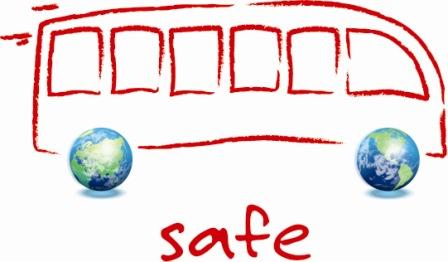 Localisation technologies, such as GPS, allow not only the development of warning and safety systems, but also provide important information to bus and coach passengers as well as to the drivers themselves. Localisation technologies, such as GPS, allow not only the development of warning and safety systems, but also provide important information to bus and coach passengers as well as to the drivers themselves.
In rural and sparsely populated areas, satellite navigation systems might be especially useful, when it comes to on-demand bus and coach services. Such systems are also effective in urban agglomerations. The integration of localisation technologies in mobile phones is another step towards the simplification of bus and coach services.
Example: POSTBUS from Austria introduced such an ‘order bus service’ called BEHA-Points in rural areas of Austria. High-quality services are provided according to the actual demand of passengers. People can order the bus service either through pushing a button at BEHA-Terminals, or via SMS, Internet, phone or pre-ordering directly with the bus driver. The BEHA system has been broadly accepted by customers and a remarkable increase in cost-efficiency has been proven.
In the city of Nantes, thanks to the MOBITrans passengers can obtain real-time information about the next two waiting times at bus and tram stations on their mobile phones. This allows passengers to better plan their time when taking public transport.
|
For more information:
BEHA-Points: The flexible future for bus-stops, Postbus, IRU
Localisation par satellite et transports collectifs, Rapport de synthèse, ATEC-ITS France, pp.4-5
Mobitrans : l’information sur les bus et trams de Nantes en temps réel sur son mobile, ALTIVIS
MOBITrans, un service innovant et gratuit d’information trafic en temps réel sur téléphone portable, Transdev
Green paper on satellite navigation applications, European Commission, pp.4-6
|
|
// Online look-up schedules and trip planning
|
|
  New technology, such as online look-up schedules, trip planning tools. or SMS notifications providing users with instant messages about delays or new services considerably help in service management and ticketing. New technology, such as online look-up schedules, trip planning tools. or SMS notifications providing users with instant messages about delays or new services considerably help in service management and ticketing.
Combining GPS, cellular, interactive displays, computer-aided dispatch and automatic vehicle location system and other tech tools, location tracking capabilities for vehicles also improve while enhancing support for operators to communicate in real-time.
Examples: Calgary Transit has therefore become among the first Canadian major urban systems to make use of new technology for use by customers when planning their route. A smart card ‘intelligent payment’ system was integrated during summer 2012. Because it makes 100 million annual passenger trips (there are nearly 1,000 buses) with more expected in the near future, Calgary Transit needed a more capable and scalable way to manage it all.
Multi-modal travel information via a smartphone has been extended in Scotland and Wales with the launch of two new apps for Blackberry and Android, showing live and scheduled bus times at selected stops. The apps are personalised and location-aware. Users can browse a map and click on stops to see live and scheduled bus times.Other features include road traffic updates, multi-modal journey planning, local taxi numbers and live news updates.
|
|
For more information:
www.calgarytransit.com
Download Traveline Scotland
|
| // Collaborative communities for bus mapping and scheduling |
|
   Mobile phone applications can enable bus riders to track their current location while riding the bus and, in turn, share this information with people who are still waiting, thereby creating a more complete map and schedule of bus routes and times, on a collaborative, hence low-cost basis. Mobile phone applications can enable bus riders to track their current location while riding the bus and, in turn, share this information with people who are still waiting, thereby creating a more complete map and schedule of bus routes and times, on a collaborative, hence low-cost basis.
This same data can eventually be used by the city or county transit authorities to improve travel times and inform riders of slow buses. It allows cash-strapped transit systems to add GPS functionality to their lines.
Example: The Tiramisu app designed for Pittsburg, USA, requires that the rider activates the tracker in order to see when the next bus is due to arrive as well as its current “fullness", which can be registered by riders. When he or she boards, the application sends the bus’ location to the main server so other riders can tell where that particular bus is and when it will arrive.
“While better funded transit systems, such as those in Chicago, Seattle and San Francisco, can afford to make GPS-based information available to riders in real-time, the Allegheny County system is under tremendous budget pressure,” Steinfeld said. “Under such circumstances, a free, crowdsourced system such as Tiramisu offers an important alternative.”
|
|
For more information:
Download Tiramisu |
|
// POSTBUS - An innovative call system (IRU Eurochallenge 2005 award winner)
|
|


Read more about ÖBB-Postbus GmbH on the web
|
|
     |
| Subscribe to the newsletter |
|
